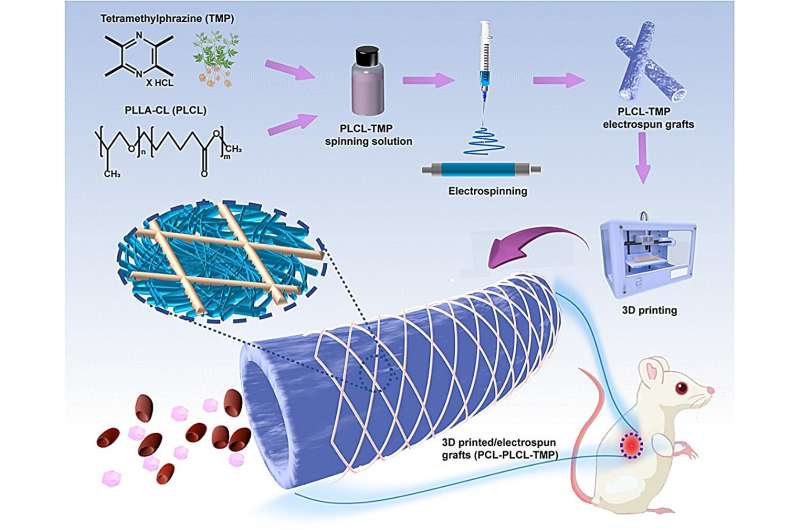This article has been reviewed according to Science X's editorial process and policies. Editors have highlighted the following attributes while ensuring the content's credibility:
fact-checked
proofread
3D-printed grafts: A potential breakthrough in combating post-surgical thrombosis and aneurysm

A new study presents the development of 3D printed electrospun vascular grafts infused with tetramethylpyrazine (TMP), offering a potential solution to reduce thrombosis and restrain aneurysmal dilatation post-surgery. This innovation has potential implications for improving cardiovascular disease treatments.
Cardiovascular disease, causing over 18 million deaths annually, often requires vessel replacement due to severe stenosis or occlusion. Autologous blood vessels are limited, leading to an interest in vascular tissue engineering. However, thrombosis and aneurysmal dilatation remain significant challenges. Based on these challenges, it is crucial to explore innovative solutions for vascular graft development.
A team from Donghua University and Shanghai Jiao Tong University has published their study on this topic in Burns & Trauma. They developed 3D-printed electrospun vascular grafts loaded with TMP to overcome limitations of current grafts. The study highlights the grafts' fabrication, characterization, and successful implantation in rat abdominal aortas.
This study focuses on developing vascular grafts to address common post-surgical complications like thrombosis and aneurysmal dilatation. Researchers combined electrospinning and 3D printing to create these grafts, with the inner layer made of electrospun poly (L-lactic-co-caprolactone) (PLCL) nanofibers and the outer layer consisting of 3D-printed polycaprolactone (PCL) microfibers. This dual-layer design enhances mechanical stability and flexibility.
Incorporating tetramethylpyrazine (TMP), derived from the traditional Chinese medicine Ligusticum chuanxiong, added significant antiplatelet and anticoagulant properties to the grafts. In vitro tests showed the grafts effectively reduced platelet adhesion and exhibited good cytocompatibility with human umbilical vein endothelial cells.
In vivo experiments, where rat abdominal aortas were replaced with these grafts, demonstrated excellent biocompatibility and mechanical strength over six months. The grafts maintained patency without acute thrombosis or significant aneurysmal dilatation, indicating their potential effectiveness in clinical settings.
This innovative approach holds promise for improving outcomes for patients requiring vascular grafts, tackling both mechanical and biological challenges in vascular tissue engineering.
Dr. Hongbing Gu, a lead researcher, stated, "This study marks a significant advancement in vascular tissue engineering. The combination of electrospinning and 3D printing, along with the incorporation of TMP, has resulted in a vascular graft that not only meets mechanical requirements but also exhibits excellent blood compatibility. These findings pave the way for future clinical applications."
The successful development of 3D-printed electrospun vascular grafts loaded with TMP offers promising solutions for cardiovascular disease treatments. These grafts could potentially reduce postoperative complications such as thrombosis and aneurysmal dilatation, improving patient outcomes. Future research will focus on long-term results in larger animal models and further exploration of the molecular mechanisms involved in vascular regeneration.
More information: Yihong Shen et al, Development of 3D printed electrospun vascular graft loaded with tetramethylpyrazine for reducing thrombosis and restraining aneurysmal dilatation, Burns & Trauma (2024). DOI: 10.1093/burnst/tkae008




















